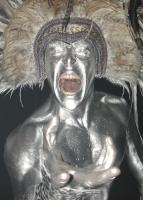Famous Statues and Monuments of Acapulco: History, Art, and Culture
Acapulco’s iconic statues and monuments, each with unique stories reflecting the city’s rich history, culture, and global connections
Acapulco is home to many statues, often serving as landmarks and points of reference. Locally, a "traffic circle" is called a "glorieta," and many statues are placed at these locations.
- La Sirena Costeña (a.k.a. La Sirena Robusta) Marking the entrance to the expressway toward Zihuatanejo/Ixtapa, the Mermaid of the Coast—popularly nicknamed "La Sirena Robusta" (The Robust Mermaid)—is one of Acapulco's most controversial statues. Created by local sculptor Samuel Muñúzuri and donated in 2008, it was intended to become an "Acapulco icon." However, the statue faced harsh criticism for its unconventional design and perceived insult to the women of Guerrero. Some viewed the piece as portraying local women as tacky, pretentious, and overweight. The backlash was so intense that Muñúzuri even offered to remove it to prevent vandalism. Despite the controversy, it remains standing and has become a curious tourist attraction.
- Agustín Lara Located at the glorieta near Playa Caleta, this statue honors Agustín Lara, famously known as "El Poeta Musical" (The Musical Poet). He was one of Mexico's most influential songwriters before World War II.
- Coat of Arms of the King of Saudi Arabia This statue, a gift from Saudi Arabia, is located along the Costera in front of the Grand Hotel Acapulco.
- José Rizal Situated on the Costera at Fernando de Magallanes, this statue was donated by the Filipino Embassy. José Rizal, a national hero of the Philippines, advocated for Philippine independence through peaceful resistance to Spanish colonial rule.
- La Diana Cazadora "La Diana" is the most famous statue in Acapulco's traffic circles. Positioned at the bustling Diana Glorieta, near Galería Diana shopping mall and close to Condesa Beach, this bronze statue of a nude, life-sized huntress drawing her bow has become an iconic symbol of the city. The nightlife scene around this area thrives.
- Monument to La Nao de China Located in La Quebrada, this monument honors the historic trade route between Acapulco, Southern China, and the Philippines. "Nao" is an old term for "navio" (ship). Acapulco celebrates this history with the annual Festival of La Nao, featuring performances from Pacific Rim countries.
- Mahatma Gandhi This life-size bronze statue of Gandhi, holding a walking stick, is located on the Costera at Juan Serrano in Costa Azul. A gift from the Indian Embassy, it commemorates Gandhi's philosophy of non-violent resistance.
- Miguel Alemán Near La Diana, this statue honors Miguel Alemán, the namesake of the Costera Miguel Alemán. As Mexico's first civilian president after the revolution, Alemán played a key role in modernizing Acapulco, improving its infrastructure, and promoting tourism.
- José María Morelos Obelisk Positioned on the Costera Miguel Alemán near Calle 5 de Mayo, this obelisk commemorates José María Morelos, a revolutionary leader from Michoacán who fought for Mexico’s independence from Spain.
- Pharaoh Tuthmosis III A gift from the Egyptian Embassy, this statue of Pharaoh Tuthmosis III, a prominent 15th-century BC monarch, stands in front of the Casa de la Cultura.
- Rotunda of the Illustrious Men Located at Playa Tlacopanocha near the downtown pier and Zócalo, this memorial pays tribute to some of Mexico's most honored historical figures.
- Samurai Sculpture Donated by the Japanese Embassy, the Samurai statue stands on Avenida Costera Miguel Alemán near Carabela Santa María.
- Simón Bolívar This bronze statue of Simón Bolívar, a key figure in South America's fight for independence, is located on the Costera Alemán in front of the CICI Water Park. It was a gift from the Venezuelan Embassy.












